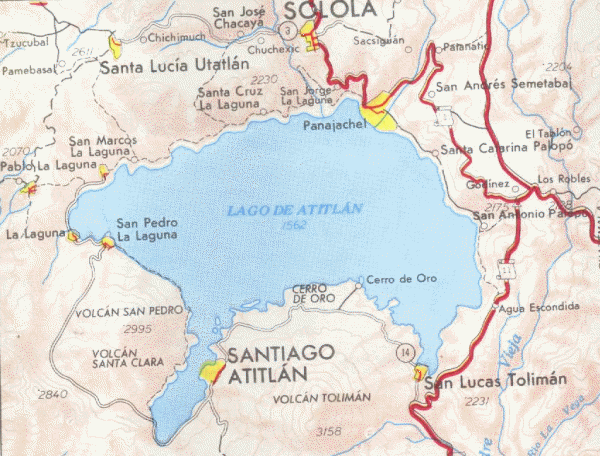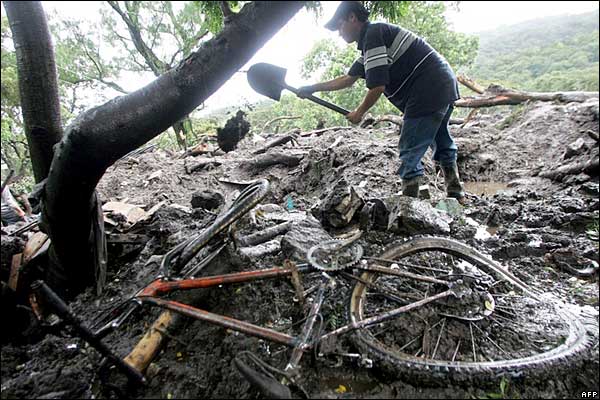
NOVEMBER 2005
 santiago atitlan In Guatemala, whole communities appear to have been wiped out by the mudslides triggered by Tropical Storm Stan. Rescue work has been halted in some areas after it was deemed too dangerous to dig for more bodies. Officials want some villages to be declared mass graves  Torrential rains in the wake of Hurricane Stan brought devastating landslides crashing on to the town's Panabaj area. Hundreds of homes were buried under mud up to 12m (40ft) deep and a thick slick poured into the corridors of the hospital. The indigenous Mayan Tzujuhil people dug desperately in search of friends and relatives swallowed by the mud - but eventually the hundreds missing were declared dead. Meanwhile the hospital staff - mostly volunteers from US-based charity Pueblo a Pueblo - moved their patients to the nearest safe building and carried on treating a stream of injured and traumatised people. No-one yet knows whether the move is permanent - or whether in a few weeks or months time they will return to the original site, now yards from the mud tomb of hundreds of villagers. "There are cultural fears [of the spirits of the dead] - so there's the question, would we be allowed back, would the patients come back?" said Dr Page. "There's another question arising and that is, is that area prone to another landslide? We're hoping a geologist will tell us if it's safe to come back and build." That question also hangs over those villagers who survived - but lost their homes and everything they owned. "We still have 5,000 people in shelters - that's the best estimate I've heard - and they are guessing probably a thousand dead," said Dr Page. Meanwhile, patients have been showing up at the new hospital mostly with minor complaints. "I think they are really here for us to say 'It's okay, you are going to live through this'. Nobody thought they would wake up one morning to find their neighbour had disappeared," Dr Page said. Close-knit community Leah Abraham, another volunteer doctor who was in Panabaj on the night of the mudslides, said it had taken time for the magnitude of the disaster to sink in with villagers. "They are suffering tremendously. The people who lost their family members are also the people who lost their homes, so they are in the refugee centres, living in terribly hard conditions. "The area that was hit the worst was the most impoverished area of the town. A lot of people, I think mostly the refugees, are pretty despondent." However, those residents unaffected by the mudslides have come together to help those who have lost everything, she said. "The indigenous community is very close-knit and doesn't have a lot of contact with the outside world - so the idea of moving to another location would be unthinkable to them," she added. Some medical supplies
are still needed and the future remains uncertain
- but two days after the Hospitalito, as it's
called, officially opened its doors at the new
site, the first baby was delivered. It
represents, perhaps, a sign of hope for the
hospital and the community it serves. |
Mexico City
Seamstresses Remember
Two Decades of Aftershocks from Mexico's 1985 Earthquake
By Laura Carlsen
October 17, 2005
Siri D. Khalsa
Outreach Coordinator
International Relations Center (IRC)
siri@irc-online.org
| 505.388-0208 vox | 505-388.0619 fax
IRC | www.irc-online.org
| "People-Centered Policy Alternatives Since
1979"
Home of IRC
Americas Program | Foreign
Policy In Focus | Right Web
Twenty years ago, on September 19th 1985, an 8.0
earthquake struck Mexico City. Over 20,000 people died
that day, or in the aftershock the following day. A
nation mourned, surrounded by a devastation unimagined in
the complacency of urban daily life. But as in the 2005
hurricane that hit New Orleans, the wreckage revealed
that the fault lay not so much in the natural disaster as
in disasters of the human variety.
In Mexico’s capital, many of the buildings that
crumbled were found to be substandard constructions where
money saved on cheap materials and feeble foundations had
gone straight into the pockets of corrupt politicians.
Among the earthquake victims were hundreds of
seamstresses who worked in the sweatshops of a downtown
zone called San Antonio Abad. The death toll that mounted
in the weeks after the earthquake was boosted by shop
owners who used heavy equipment to remove sewing machines
and industrial goods while leaving women workers
hopelessly trapped in the ruins.
Survivors told horror stories of being locked in
overcrowded rooms with no escape routes, no direction,
and no hope as the buildings fell. Their indignation
turned to rage when, left jobless, their bosses refused
to pay wages due and severance pay. Then their rage
turned into a union.
The women workers formed Mexico’s first women-led,
independent union in decades: the September 19th
Seamstresses Union.
The first few years passed quickly in union meetings,
street mobilizations, and marches, international
solidarity tours. Feminist and labor union activists
descended on the union with offers of help and advice.
They were heady days of women’s empowerment,
confronting the establishment, and discovering newfound
talents and challenges.
But at the same time, the struggle for collective
contracts was an increasingly uphill battle. Official
union thugs beat up seamstresses from the new union and
bought off union elections. Owners closed down shops with
hard-won union contracts and simply opened up elsewhere.
If some walls had fallen in the quake, for the struggling
union others were standing as thick and impenetrable as
ever.
The clothing industry grew at first under NAFTA, fuelled
by investment in the export maquiladora sector and later
the 1995 peso devaluation that cut labor costs, but in
2000 it began a steep decline that is expected to deepen
in coming years. China’s entry into the WTO and the
end of the Multifiber Act have opened up global
competition for production that drives wages into the
ground and closes factory doors forever. The $2.45 an
hour in wages and benefits on average paid legally
employed Mexican workers, looks like a fortune next to
the 27 cents an Indonesian worker earns, or the 68 cents
paid Chinese clothing workers.
Globalization of the clothing industry set off a race to
the bottom that has led to the loss of nearly 200,000
jobs in the Mexican clothing industry since 2000. Export
jobs have gone to countries where workers earn even less.
Many more shops have gone underground. Mexico’s
Economy Ministry estimates that 58% of the national
market is illegalincluding goods produced in the
informal economy, contraband, and stolen goods.
Marisol Hernandez, press secretary of the September 19th
Union in its early days, comments on the then-and-now of
a lifetime of stitching t-shirts. After the union fell
apart in the early 90s, she found a job sewing in a large
factory owned by a Mexican company. Several years ago,
the factory was bought by Sara Lee, producers of the
Hanes brand. Not long after, the factory closed its doors
on the 6,000 workers in the Mexico City plant and moved
to the state of Aguascalientes.
Although Sara Lee paid legal requirements to laid-off
workers, this is not the first time that the company has
closed a plant to seek greener pastures (lower wages)
elsewhere. Workers at the Mexico City factory report that
after working up to wages of around $20 a day, the
factory was offering Aguascalientes workers only $5 a
day.
In a nation facing a deficit of over a million jobs, the
prospects for a middle-aged woman in the formal economy
are little to none. Mexico City’s Sara Lee workers
were sent first to another factory, but the wages were
only $30-40 a week. Many, like Marisol, have turned to
piecework in the home. A men’s shirt goes for $2
and, according to Marisol, if she really hurries she can
earn $90 a week. That’s without any benefits, and
the seamstresses themselves have to provide the sewing
machine, maintenance, and utilities.
As for the union, infighting among the feminist and labor
advisors, free trade, and an industry built on
union-busting all contributed to its demise.
The short but luminous history of the “union born of
the ruins” left its mark on Mexican labor history in
more ways than one. Ultimately, it failed as both a tool
for defending the rights of workers and as a catalyst for
a feminist-labor movement. Its sad end marked the stark
limitations of a national labor movement in a globalized
economy and the costs of imposing warring ideologies on a
fledgling workers’ organization.
Failed, but not without forging major changes in the
lives of its members. As the young son of union leader
Rafaela Dominguez put it during the hyperactive days of
union organizing, “Mommy, when the earth shook, it
left its shaking in you!”
Many continue to shake. Union member Concepción Guerrero
worked for years at the cooperative formed by the union.
Following the Zapatista uprising, she became a dedicated
supporter of the indigenous communities in Chiapas and in
her native state of Guerrero. Other members of the union
continue to be active in the Urban Popular Movement, and
many still work and live together in low-income housing
communities won through the struggles of the late 80s.
The experience of leadership, public participation, and
empowerment they gained in the union may not have changed
the world, but for many it profoundly and permanently
modified the parameters of their personal relationships
and sense of self. “No-one can take from us what we
learned during those years,” says Marisol. “I
know where I stand now. I’m a seamstress and I have
rights.”
But, 20 years after the earthquake and the surge of
popular organizing, Mexico seems to have learned nothing
from the experience. The labor movement continues to be
controlled by unions bound to management or to the former
ruling Party of the Institutional Revolution (PRI). In
most cases, it’s both. The ever-more-real threat of
flight paralyzes workers in a survival mode of existence.
In a recent interview with the Mexican daily La Jornada,
Evangelina Corona, former secretary general of the union
summed up the experience somewhat bitterly: “We are
still victims, though not of the earthquakebut of the
government, of the free trade agreement signed by former
President Carlos Salinas de Gortari that was the tomb of
so many industries and the father of unemployment. We are
the victims of corrupt labor and we are trapped by
need.”
Indeed, manufacturing wages lost 41% of their value
between 1982 when the economy began liberalization and
2000. Mexico’s gender development index of equity
for women has remained relatively stagnant over the past
years of a radical free trade economy. Women workers
continue to be the worst paid and the most vulnerable, as
seen by the murdersmany of maquiladora workersin
Ciudad Juarez on the northern border. The deep dividing
line of race, often unacknowledged in a mestizo (mixed)
society, shows up unmistakably in the moreno faces of the
seamstresses, the factory workers, and the murdered
women.
There is only one gain that natural disaster and the
human disasters of free trade, unemployment, and sexism
cannot take backthe change within. “Before we were
completely submissive,” says Marisol. “If they
told us to go back in to work in a falling down building,
we went. But now none of us will do what is unjust. As
people, our way of thinking has changed.”
Marisol’s young daughter Dulce plays in the next
room. With any luck, and, one hopes, without need of a
natural disaster as a catalyst, she will carry on where
her mother’s generation leaves off.
Laura Carlsen directs the Americas Program of the
International Relations Center (online at
www.irc-online.org) in Mexico City. She worked with the
September 19th Seamstresses Union from 1986-1989.
